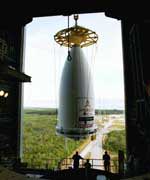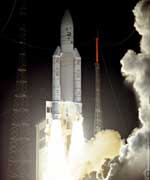In a span of less than 10 hours, International Launch Services (ILS) placed two satellites in orbit today from space centers on opposite sides of the world.
The flights were carried out by, respectively, a Russian-built Proton/Breeze M vehicle from Baikonur and an American Atlas III vehicle from Cape Canaveral. ILS, a joint venture of Lockheed Martin of the United States (NYSE: LMT) and Khrunichev of Russia, markets both vehicles worldwide and manages the missions.
These back-to-back launches were the first missions in a busy year for ILS.
?No one else can do this,? said ILS President Mark Albrecht. ?The cornerstone of ILS is offering two independent vehicles, launching from independent launch sites, which enables us to service two customers at the same time.?
The Proton vehicle lifted off at 9:27 p.m. EST Wednesday (7:27 a.m. today in Baikonur, 2:27 today GMT), carrying the AMC-12 satellite for SES AMERICOM. After about 9 hours and 19 minutes of flight, the satellite separated from the launcher and went into orbit. AMC-12 is expected to go into service in April, providing communications for the Americas, Europe, the Middle East and Africa. The satellite was built by Alcatel Space of France.
The Atlas III vehicle, designated AC-206, lifted off from Cape Canaveral?s Space Launch Complex 36B at 2:41 a.m. EST (7:41 GMT) with a payload for the National Reconnaissance Office. The payload was released into orbit about 79 minutes later. Details about the payload and mission, known as NROL-23, are classified.
?What an accomplishment!? said Albrecht. ?We have had tandem missions before, and it?s challenging and exciting, especially for those of us watching from ILS headquarters. The teams on site focus on only one thing ? the success of their particular mission.?
Dual capabilities give ILS ?a robust launch tempo,? Albrecht said. ?Both vehicles launch commercial and government missions, which keep the manifests busy and keep the teams sharp.?
These launches set records for ILS, namely:
* Shortest timespan between launches on both vehicles: 5 hours and 14 minutes (previous records were 7 hours, 10 minutes on Aug. 21/22, 2002, and 9 hours, 12 minutes on June 30/July 1, 2000).
* 75th consecutive successful Atlas launch.
* Final launch of Atlas III vehicle, the second Atlas family to have achieved 100% success throughout its lifetime.
* 5th launch in 12 months for a single customer ? SES AMERICOM (AMC-10 on Atlas Feb. 5, 2004; AMC-11 on Atlas May 19, 2004; AMC-15 on Proton Oct. 15, 2004; AMC-16 on Atlas Dec. 16, 2004; and AMC-12 on Proton Feb. 3, 2005).
The next scheduled ILS mission is at Cape Canaveral in March, an Atlas V launch with the Inmarsat 4-F1 satellite. Another Atlas V is scheduled to launch the Mars Reconnaissance Orbiter for NASA in August. Proton missions planned through the rest of the year include communications satellites for DIRECTV, MEASAT, Telesat Canada, SES AMERICOM, SES GLOBAL and Arabsat.
This followed a year in which ILS launched 10 satellites, all successfully ? six on Atlas and four on Proton. The Russian government also used Proton for four missions. With a remarkable launch rate of 72 missions since 2000, the Atlas and Proton launch vehicles have consistently demonstrated the reliability and flexibility that have made them the preferred choice among satellite operators worldwide. Since the beginning of 2003, ILS has signed more new commercial contracts than all of its competitors combined.
ILS was formed in 1995, and is based in McLean, Va., a suburb of Washington, D.C.
Original Source: ILS News Release


